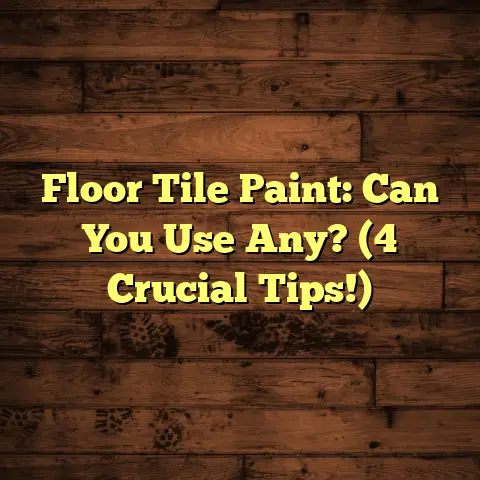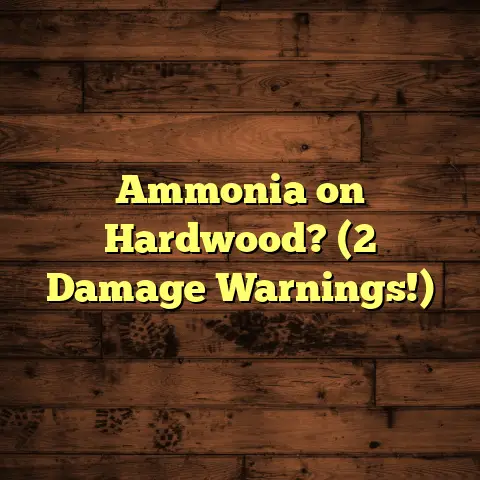Epoxy Flooring Cost Philippines (Explained)
Epoxy flooring has become increasingly popular in the Philippines for both residential and commercial spaces, lauded for its durability, aesthetic appeal, and low maintenance requirements.
However, understanding the costs associated with installing epoxy flooring is essential for effective budgeting and planning.
Overview of Epoxy Flooring
Before we dive into the costs, let’s briefly discuss what epoxy flooring is.
Epoxy is a type of resin that, when mixed with a hardener, forms a durable and resilient surface.
It is commonly used in industrial settings, garages, and increasingly in homes due to its seamless finish and ability to withstand heavy foot traffic and spills.
Benefits of Epoxy Flooring
- Durability: Epoxy floors are known for their ability to withstand heavy use, making them ideal for commercial settings as well as busy homes.
- Low Maintenance: Cleaning epoxy floors is straightforward.
Regular sweeping and mopping are typically sufficient to keep them looking good. - Aesthetic Appeal: Available in a variety of colors and finishes, epoxy can be tailored to fit any design theme.
- Chemical Resistance: Many epoxy formulations are resistant to chemical spills, making them suitable for garages and workshops.
Major Cost Factors Affecting Epoxy Flooring Installation
When estimating the cost of epoxy flooring installation in the Philippines, several key factors play a significant role:
1. Area Size
The total area to be covered is a primary factor in determining the overall cost.
Larger spaces may benefit from bulk pricing, while smaller areas might incur higher per-square-meter costs.
For instance, a small room may cost more per square meter compared to a large warehouse due to fixed costs associated with installation.
2. Material Type
Different types of epoxy come at varying price points.
Standard epoxy coatings are generally less expensive than high-performance or decorative options.
Some popular types include:
- Standard Epoxy Coating: A basic option suitable for residential and light commercial use.
- Self-Leveling Epoxy: Designed to fill in imperfections on the floor, creating a smooth surface.
- Decorative Epoxy Systems: These include flake systems or metallic finishes that provide visual appeal but may come at a premium price.
3. Labor Costs
Labor costs can vary based on the complexity of the project and the expertise of the installers.
Experienced professionals may charge more but ensure a quality finish.
In the Philippines, labor costs might range from ₱300 to ₱800 per square meter depending on the contractor’s experience and reputation.
4. Floor Preparation
Proper floor preparation is crucial for ensuring the longevity and durability of epoxy flooring.
If the existing floor requires extensive preparation, such as removal or resurfacing, this can add to the overall cost.
Typical preparation might include:
- Cleaning: Removing dirt, grease, and residues from the existing surface.
- Repairing Cracks: Filling in any cracks or holes before applying epoxy.
- Grinding or Shot Blasting: Creating a rough surface for better adhesion of the epoxy.
5. Additional Considerations
There are several other factors that can impact the overall cost of epoxy flooring installation:
- Subfloor Replacement: If the subfloor is damaged or unsuitable for epoxy application, replacing it can increase costs significantly.
- Material Grade: Higher-grade materials typically cost more but offer better durability and aesthetics.
- Room Size/Layout: Unusual shapes or layouts may require more intricate cutting and installation techniques, impacting labor costs.
- Installation Type: Different installation techniques can impact costs, including self-leveling, flake systems, or metallic finishes.
Detailed Cost Breakdowns
Cost Per Square Meter
The cost of epoxy flooring in the Philippines typically ranges from ₱1,200 to ₱2,500 per square meter, depending on the factors mentioned above.
Here’s a breakdown based on specific scenarios:
- Basic Epoxy Coating: ₱1,200 – ₱1,800 per square meter
- Self-Leveling Epoxy: ₱1,800 – ₱2,200 per square meter
- Decorative Epoxy Systems (Flake or Metallic): ₱2,000 – ₱2,500 per square meter
Example Cost Estimates
To provide a clearer picture of potential expenses, here are example cost estimates based on common room sizes:
1. Small Room (20 sqm)
- Basic Epoxy:
- Material Cost: ₱24,000 – ₱36,000
- Labor Cost (₱300/sqm): ₱6,000
- Total Cost: ₱30,000 – ₱42,000
- Self-Leveling:
- Material Cost: ₱36,000 – ₱44,000
- Labor Cost (₱400/sqm): ₱8,000
- Total Cost: ₱44,000 – ₱52,000
- Decorative:
- Material Cost: ₱40,000 – ₱50,000
- Labor Cost (₱500/sqm): ₱10,000
- Total Cost: ₱50,000 – ₱60,000
2. Medium Room (50 sqm)
- Basic Epoxy:
- Material Cost: ₱60,000 – ₱90,000
- Labor Cost (₱300/sqm): ₱15,000
- Total Cost: ₱75,000 – ₱105,000
- Self-Leveling:
- Material Cost: ₱90,000 – ₱110,000
- Labor Cost (₱400/sqm): ₱20,000
- Total Cost: ₱110,000 – ₱130,000
- Decorative:
- Material Cost: ₱100,000 – ₱125,000
- Labor Cost (₱500/sqm): ₱25,000
- Total Cost: ₱125,000 – ₱150,000
3. Large Area (100 sqm)
- Basic Epoxy:
- Material Cost: ₱120,000 – ₱180,000
- Labor Cost (₱300/sqm): ₱30,000
- Total Cost: ₱150,000 – ₱210,000
- Self-Leveling:
- Material Cost: ₱180,000 – ₱220,000
- Labor Cost (₱400/sqm): ₱40,000
- Total Cost: ₱220,000 – ₱260,000
- Decorative:
- Material Cost: ₱200,000 – ₱250,000
- Labor Cost (₱500/sqm): ₱50,000
- Total Cost: ₱250,000 – ₱300,000
Comparison with Alternative Flooring Options
When considering flooring options for your space, it’s important to compare epoxy flooring with alternatives such as laminate, vinyl, and carpet.
Here’s a comparative analysis:
Detailed Comparison
Durability
Epoxy flooring is highly durable and can withstand heavy foot traffic and spills without sustaining damage.
In contrast:
- Laminate can scratch easily and is less water-resistant.
- Vinyl offers moderate durability but may wear out in high-traffic areas.
- Carpet, while comfortable underfoot, can wear down quickly and stain easily.
Maintenance
Maintenance requirements vary greatly among these flooring types:
- Epoxy floors require minimal upkeep; regular sweeping and occasional mopping are sufficient.
- Laminate and vinyl floors need regular cleaning but may also require occasional deep cleaning.
- Carpet demands frequent vacuuming and periodic professional cleaning to maintain appearance.
Aesthetic Appeal
Aesthetics can be subjective based on personal taste:
- Epoxy flooring offers a modern look with various styles available.
- Laminate and vinyl can mimic the appearance of wood or tile but may lack authenticity.
- Carpet provides warmth but may not suit all design themes.
Signs Your Epoxy Floors Need Replacement
It’s essential to know when it’s time to replace your epoxy flooring to avoid further damage and maintain the aesthetic appeal of your space.
Here are some signs that indicate replacement is necessary:
1. Cracking or Peeling
If you notice cracks or peeling in your epoxy flooring, this may indicate poor adhesion or damage caused by improper installation.
These issues can compromise the integrity of the floor.
2. Discoloration or Stains
Persistent stains that cannot be cleaned or significant discoloration may signal that your epoxy floor has reached the end of its life cycle.
3. Water Damage
Signs of moisture beneath the surface can lead to mold growth and other issues if not addressed promptly.
4. Surface Wear
Excessive wear in high-traffic areas may warrant replacement if it compromises safety or aesthetics.
Refinishing vs. Replacement
When faced with worn-out epoxy floors or visible damage like scratches and discoloration, it’s crucial to consider whether refinishing is an option or if full replacement is necessary.
Refinishing
Refinishing is viable if the surface is still structurally sound but shows signs of wear.
This process typically involves:
- Sanding down the existing surface to remove imperfections.
- Applying a new layer of epoxy coating.
- Allowing adequate curing time before resuming use.
Refinishing can save money compared to complete replacement while extending the life of your flooring.
Replacement
Replacement becomes necessary when:
- The flooring has significant structural problems.
- There is extensive damage throughout the area.
- A change in design or functionality is desired.
Professional Installation vs. DIY
When considering how to install your epoxy flooring, you will face the choice between professional installation and taking on a DIY project.
Cost Differences
Hiring professionals typically incurs higher upfront costs but ensures a quality job done right.
DIY can save money but requires knowledge and skill in floor preparation and application techniques.
Here’s a breakdown of potential costs:
Importance of Proper Installation
Proper installation is crucial for ensuring durability and performance.
Mistakes can lead to costly repairs down the line.
Hiring experienced professionals often pays off in terms of longevity and appearance.
Questions to Ask Hardwood Flooring Contractors
Before hiring a contractor for your epoxy flooring project, consider asking these essential questions:
- What is your experience with epoxy flooring installations?
- Can you provide references from previous clients?
- What types of epoxy do you recommend for my project?
- How long will the installation take?
- What is included in your warranty?
- How do you handle unexpected issues during installation?
- What preparation work will be needed before installation?
- Do you have insurance coverage for your work?
- What steps do you take to ensure proper ventilation during installation?
- How do you handle cleanup after the job is finished?
These questions will help you gauge a contractor’s expertise and ensure you’re making an informed decision.
Care and Maintenance Tips for Epoxy Floors
To maximise the longevity of your epoxy flooring and keep it looking its best:
Regular Cleaning
Sweep or vacuum regularly to remove debris that could scratch the surface.
Using a soft broom or vacuum with a soft brush attachment is recommended.
Mopping
Use a damp mop with mild detergent specifically designed for epoxy surfaces for deeper cleaning.
Avoid using harsh chemicals that may damage the finish.
Avoid Harsh Chemicals
Strong cleaning agents can degrade the epoxy surface over time.
Stick to gentle cleaners that are safe for use on epoxy flooring.
Protect from Heavy Impact
Consider using mats or rugs in high-traffic areas to prevent excessive wear and tear on your floors.
Periodic Inspections
Regularly check for signs of damage or wear—this could include cracking or signs of water intrusion—so that you can address any issues promptly before they worsen.
Conclusion
Understanding the costs associated with epoxy flooring in the Philippines is vital for making informed decisions about your flooring projects.
By considering factors such as area size, material type, labor costs, and preparation requirements you can accurately estimate your budget.
Comparing epoxy with alternative flooring options reveals its value proposition as a durable and aesthetically pleasing choice suitable for various settings.
Whether you choose professional installation or take on a DIY project yourself being aware of maintenance practices will ensure your epoxy floors remain beautiful and functional for years to come.
With this comprehensive guide at hand you are well-equipped to embark on your flooring journey confidently making informed decisions about your investment in epoxy flooring in your home or business space.
As you consider installing new floors remember that quality matters—whether it’s in choosing materials hiring skilled professionals or maintaining your floors over time ensuring that each decision contributes positively to your overall satisfaction with your investment in quality flooring solutions!





